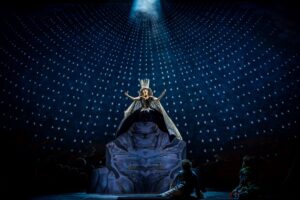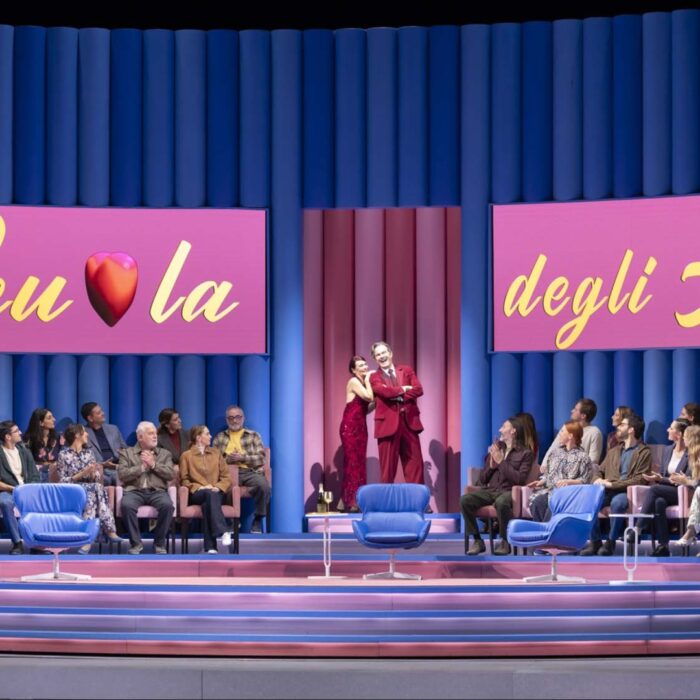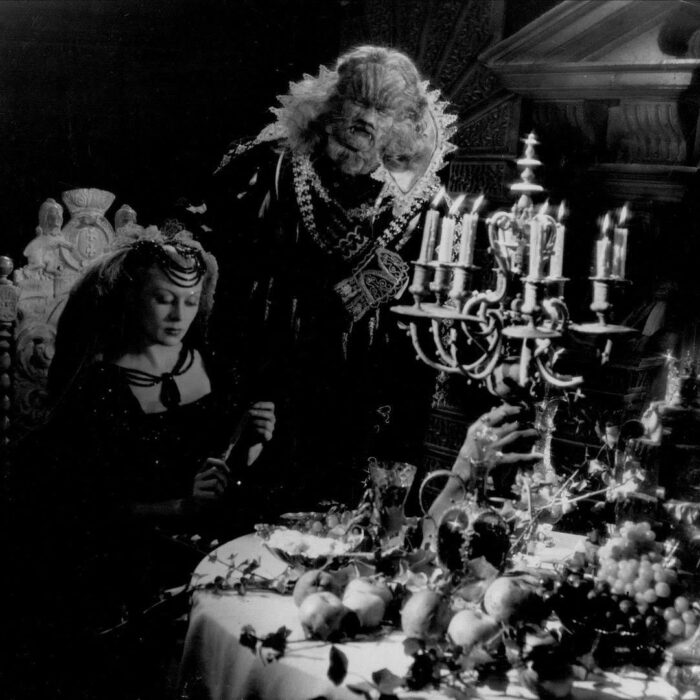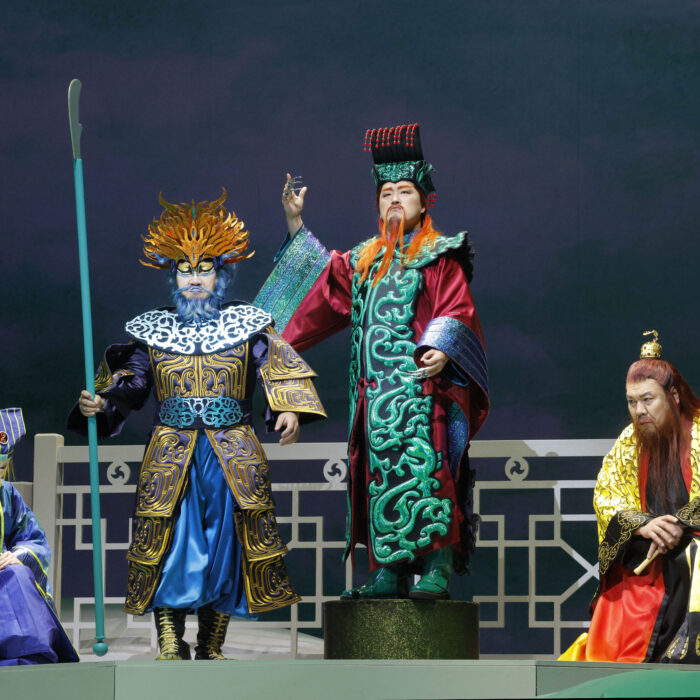
Staatstheater Kassel 2022-23 Review: Die Zauberflöte
An audacious and controversial new interpretation draws boos and audience anger.
By Barry WalshPhoto: Isabel Machado Rios
A new production of “Die Zauberflöte” at Staatstheater Kassel raised many eyebrows long before its recent premiere on 25 February 2023.
Its advanced billing described it as “participative music theatre based on the opera of the same name,” which “opens the question of interpretation to democratic vote,” so fans of Mozart’s final masterpiece were on notice to expect something very different. However, nothing could have fully prepared them for what they were about to see.
This production is highly experimental, to put it mildly, but the end result was an assault on the senses, which proved uneven and chaotic at times, and generated a hugely polarized audience response.
A steady chorus of boos and heckling during the first Act rose to a crescendo of raucous anger as the curtain descended for the interval. It was the tensest and most hostile atmosphere I have witnessed in my two decades of attending the opera.
The Concept
The directors of this new production, Barbara Frazier and Florian Lutz, seem to want to be deliberately provocative in order to test the limits of what fans of “The Magic Flute” might be willing to accept.
Mozart enthusiasts have come to love “traditional” productions such as those of David McVicar at the Royal Opera in London and Julie Taymor at the Metropolitan Opera in New York, with a historical setting of Egyptian symbolism that aligns with the Masonic themes of the opera.
However, we have come to accept productions that recontextualize the world of the enigmatic brotherhood into other male-dominated settings. Three productions from Ireland in the last decade illustrate the range of imagination.
A 2012 production by Opera Theatre Company (now part of the Irish National Opera) set in a boys’ boarding school; a 2014 production by the Blackwater Valley Opera Festival, set and performed in a circus tent; and an acclaimed 2019 production by the Irish National Opera, set in an Irish hunting lodge in the 1800s.
Aside from the overall setting, several key plot points are also open to a degree of interpretation. Is Sarastro really the good guy he appears to be? Is the Queen of the Night the root of all evil, or simply rebelling against pompous patriarchy?
August Everding’s production at the Staatsoper Berlin sees the vanquished Queen joining with Sarastro to give her blessing to the happy couple. Meanwhile, in that same city, the recent revival of Andreas Reinhardt’s production at the Deutsche Oper sees Pamina longing to rebel against the brotherhood and follow the Queen as she retreats into the darkness.
In Kassel, many variations such as these are attempted all at once, with a hodgepodge of three separate productions and multiple plot directions being presented, often simultaneously on stage. In the first thirty minutes, the audience was given a taste of three possible productions.
There was a production in a traditional historical setting with the Egyptian symbolism of Sarastro’s temple.
Another was set in the present day, which seemed to mirror the 2022 production of “Lucia Di Lammermoor” at the Metropolitan Opera in New York, with the brotherhood portrayed as a mafia organization and the Queen of the Night as the violent matriarch of a working-class family.
The third was a piece of “performance art,” with the singers behaving as improv actors or stand-up comics standing behind microphones while choosing from various costumes and props to develop the plot.
In the second Act, the audience was given a further choice of whether they wanted to see the opera reach its conclusion through the perspective of Sarastro or the Queen of the Night.
And as if all of this wasn’t enough to contend with, a narrator also appears regularly to make observations about how the different settings and directorial approaches impact the themes of sexism and racism in the libretto.
Confused? So was the audience!
The Structure
The effect of all this was quickly seen in the first 30 minutes.
The opera opened, somewhat surprisingly, by skipping the Overture and kicking straight into the action, with Tamino being chased by the (as yet unseen) snake (“Zu Hilfe! Zu Hilfe!”). After being rescued by the Three Ladies, the snake then appears for the first time to gobble up all four characters and drag them off stage, a running gag that was repeated as a device to pause proceedings.
At this point, the narrator – Katharina Brehl – intervened to explain the concept of the opera and to introduce the three productions that the audience could choose from. At first, she was greeted warmly, but with at least seven further interruptions over the course of the evening, the audience’s reaction became increasingly hostile.
Following this introduction, the orchestra then played the Overture before the arrival of the Queen of Night, who sang “O zittre nicht” in traditional costume. Brehl then interrupted to announce that the aria would be performed again in a present-day setting (thus introducing the second production), which prompted the first smattering of boos of the evening.
It was the first appearance of Monostatos which proved to be a breaking point. Brehl again interrupted to give an extended monologue, which felt more like a lecture, on the racist depiction of the character’s Moorish origins in traditional productions.
This seemed to light a spark in the theatre, which suddenly erupted with a chorus of booing, cries of “stop!” “get on with it!” and a host of expletives, emanating primarily from the dress circle.
Eventually, the exhausted audience was asked for a show of hands and overwhelmingly voted to see the traditional production, perhaps in the vain hope that the opera would then proceed as normal.
In a later vote, the audience (unsurprisingly) chose to see a conclusion through the eyes of the Queen of the Night, the more enigmatic and lesser-seen character. However, they may have regretted doing so since this appeared to partially drag the action back into a present-day production, exposing the audience to a number of developments that, it’s fair to say, they never thought they would see on an opera stage.
These included Papageno being impaled through the hand with a knife by the angry Queen, prompting audible gasps from the audience; the Queen donning a purple leather catsuit and a blonde wig, in a clear reference to Uma Thurman in the “Kill Bill” movies, and brutally slaying Sarastro and the brotherhood; and the priests later re-animating as zombies to stalk Tamino and Pamina.
And so on it went on for the entire evening.
The disjointed structure and sensational plot developments made this feel less like a full production of the opera and more like some kind of “Magic Flute” mash-up or a performance piece loosely structured around its standout arias.
For example, “Dies Bildnis ist bezaubernd schön” one of the opera’s early arias, wasn’t sung by Tamino until after the brotherhood’s blood-soaked demise in the second Act. During “Ein Mädchen oder Weibchen,” Papageno encouraged the audience to sing along, which eased the tension in the air but did little to win over those angry at the direction things had taken.
The opera’s spoken dialogue – a key part of the Singspiel form and vital to plot development here – is almost entirely culled. This leads to minor characters falling by the wayside, with Monostatos’ role being very much reduced and, bizarrely, Papagena making no appearance until the “Papageno, Papagena” duet in the penultimate scene.
All of this chopping and changing means that the opera’s messages of personal growth and enlightenment, as shown through the experiences of Tamino, Pamina, and Papageno, are almost completely lost. The trials by fire and water – a key part of their journeys – featured neither fire nor water in this production, nor any attempt to even represent them.
Singing and Design Talent
These many flaws were significantly compensated for by the quality of the voices and the artistic design in evidence.
As narrator, Katharina Brehl was warm, witty, and charming despite having to bear the brunt of the anger in the theatre.
As the Queen of the Night, Swedish soprano Ylva Stenberg was flawless for her first rendition of “O zittre nicht” and for “Der Hölle Rache.” However, during her unexpected second iteration of “O zittre nicht,” she completely missed the high F, most likely due to the frenetic physical action that the “modern” production demanded of her during an aria which is normally performed in a stationary position.
As Sarastro, veteran bass Claudius Mut had an uneven start and seemed to zip ahead of the orchestra but was otherwise sonorous and authoritative throughout. He delivered a witty monologue in the second Act, which contained a strong defense of artistic expression and soothed the audience somewhat. “The theatre is our temple,” boomed Mut, in lines that were clearly included in anticipation of a hostile audience reaction.
As Tamino, Maximilian Mayer was ideally cast for the role, with a clear, bright, and strong voice.
Clara Soyoung Lee sang Pamina’s arias beautifully from the front of the stage but was sometimes swallowed up and drowned out when the action took her further back the stage.
For what little we saw of Monostatos, Lars Rühl was suitably devilish for his rendition of “Alles fühlt der Liebe Freuden.”
In an unusual variation, the Three Boys were sung by three girls from the theatre’s youth choir. It may seem harsh to single them out, but their voices were far too light for such an imposing venue.
The striking youth of the production team, most of whom seemed to be under the age of 40, bodes well for the future of opera at the venue. They had to endure loud boos when they took to the stage at curtain call, and one hopes that this will not deter them from working on new opera productions in the future.
The sets were designed by Metschild Feuerstein, assisted by guest designer Lasse Fischer, a native of Kassel and a recent graduate of the Royal Conservatoire of Scotland in Glasgow. Their portrayal of the Queen’s “Hall of Stars” – a clear nod to the 1816 designs of Karl Friedrich Schinkel – will have delighted Mozart fans.
Their work deserves to be seen again in Kassel and further afield. However, since the audience opted for the traditional production, we saw very few of their designs for the two other alternative productions, and I was left with a sense that something had been lost.
The Staatsorchester Kassel, conducted by Kiril Stankow, was crisp and well-timed but, with the exception of the Overture, their work was entirely submerged by the drama and distractions onstage.
Final Thoughts
The final scene (“Die Strahlen der Sonne”) was performed with the stage obscured in total darkness, as a single blinding light was directed towards the audience. This interesting innovation was one of many in this production which worked well individually but which failed to fit together as part of a coherent whole.
All opera fans recognize that the genre has to expand its horizons and find ways to appeal to new audiences, and the directors have certainly attempted to do so here. Unfortunately, for all its individual artistic merits, the structure of this production will have made Mozart’s final masterpiece virtually incomprehensible to first-time opera attendees.
Nevertheless, this is a production that deserves to be seen by fans of Mozart, if only because such an audacious and controversial interpretation of “Die Zauberflöte” is unlikely to be seen again for a very long time!


